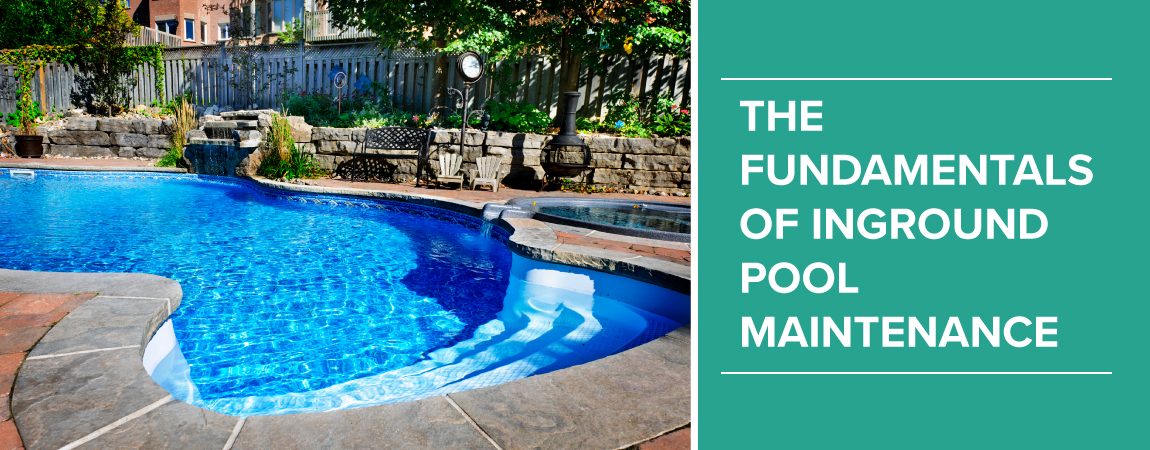
A dip in the pool refreshes you on a hot summer day, makes the perfect spot for entertaining and provides you with a fun source of exercise. All of those pool activities are much more enjoyable when the water is crystal clear and comfortable, but achieving that sparkling pool environment requires regular pool maintenance.
Read on to learn how to maintain your facilities to maximize your enjoyment of your inground pool.
Cleaning the Pool
When figuring out how to take care of a pool, cleaning is one of the most obvious tasks. To keep your pool clean and free of algae, bacteria and other contaminants, you need a regular weekly cleaning schedule. Some tasks only need to happen once per week, while others may need to happen multiple times or even daily.
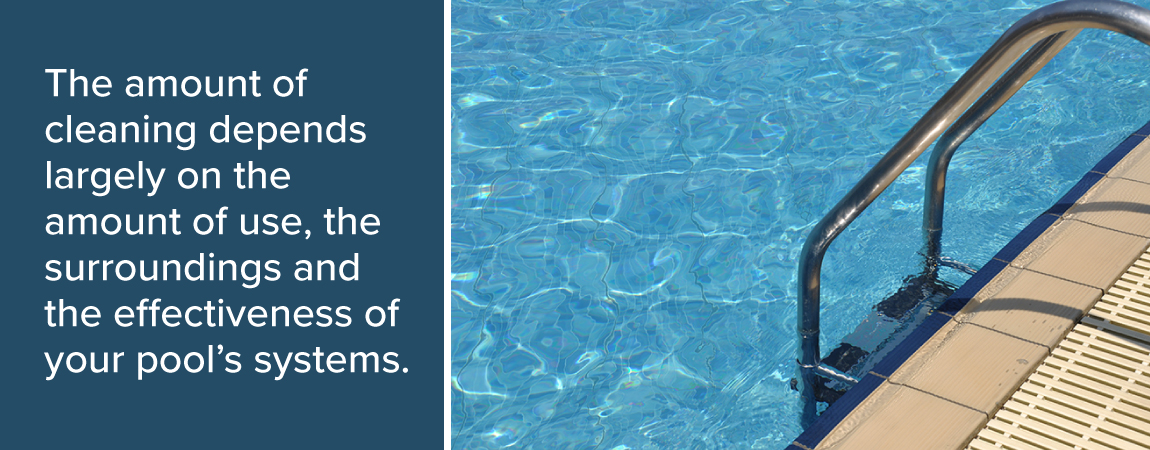
Even when your circulation and filtration systems work at peak performance, your pool still needs physical cleaning periodically. The amount of cleaning depends largely on the amount of use, the surroundings and the effectiveness of your pool’s systems.
The basics of cleaning a pool include:
- Skimming debris: Check your pool daily for leaves and other debris, both floating and on the bottom of the pool. Use a long-handled leaf skimmer net to scoop those pieces of debris out of the pool. Removing the debris right away helps keep your pool clean and safe. It can also help reduce the amount of chemicals you need, and it reduces strain on the filter system while preventing clogs. If you have lots of trees or landscaping around the pool, expect to skim more often.
- Vacuuming: Weekly vacuuming keeps the floors and walls of the pool clean. Automatic pool vacuums handle the cleaning for you, while manual vacuums use long handles to let you reach the bottom and sides of the pool. Vacuuming typically takes about 30 minutes for a thorough job in the average pool. For the best results with a manual vacuum, overlap each pass to prevent missing any areas.
- Scrubbing walls: Manually scrubbing the walls in some areas is necessary to remove algae. Focus particularly on the tile along the water line and in the corners. A nylon brush is a safe, effective tool for scrubbing.
- Emptying skimmer baskets: Your pool’s skimmer helps remove some debris. Clean out the baskets regularly to allow the system to function properly. Check them daily or multiple times per week to keep them empty. Dispose of any debris away from the pool so it doesn’t make its way back into the water.
- Cleaning pump filter: Routinely clean out the debris that accumulates in the pump filter to improve efficiency. Always shut off the system before cleaning out the filter. Close the skimmer valve to keep water in place. Take off the cover to reveal the removable basket, and pull out any debris that’s made its way inside.
- Cleaning pool deck: Spray down the area around your inground pool, directing the water away from the pool. This keeps dirt and debris out of the pool to minimize cleaning.
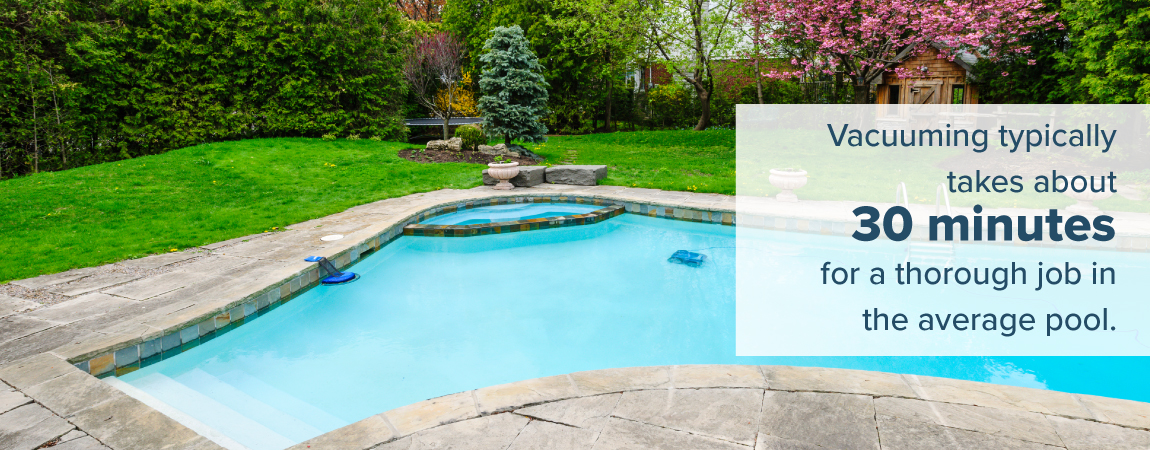
As you clean, check the water level in the pool. Letting the water decrease below the skimmer intake tubes can damage the pump, so it’s very important to maintain water levels throughout the swimming season. Evaporation and splashing cause a normal decrease in the pool’s water levels. If the water seems to drop faster than normal, you may have a leak.
Learning how to keep a pool clean is one of the easiest pool care basics that keeps the water clear and comfortable for swimmers. Establish your regular cleaning schedule based on the amount of use and amount of debris that normally accumulates in the pool.
Maintaining the Circulation and Filtration System
The next consideration in our pool care guide is the circulation system. This system draws water out of the pool, filters it and sends it back into the pool. Basic pool maintenance is much easier when your filtration and circulation system is working properly. Keeping the circulation system running properly keeps the water moving through the filter, which keeps your pool water cleaner. Clean water tends to need fewer chemicals to create a safe swimming environment.
A general guideline is to run the pool pump each day for an hour per 10 degrees. On an 80-degree day, this means the pump should run for at least eight hours.
The parts of the circulation system include the pump, pump strainer, skimmers, drains and filter. The pump is the heart of the circulation system. This is the part of the pool equipment that creates suction to move the pool water into the filter, where dirt and debris get removed. The pump also returns the water back to the pool.
The filter actually removes the dirt and particles from the water. Pool filters occasionally need cleaning to work effectively. Check the pressure gauge to determine when the filter needs to be cleaned. If the gauge reads seven to 10 pounds higher than normal, clean the filter. The pressure check is an effective method for determining the need for cleaning on all types of pool filters.
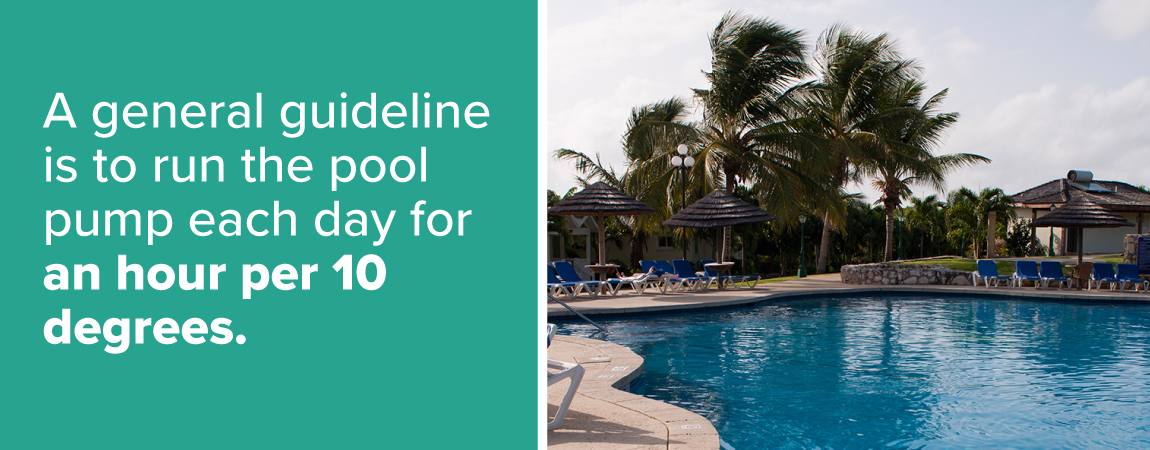
The type of filter determines the cleaning method. Use the appropriate method listed below depending on your filter type:
- Sand filter: This type of filter uses sand to pull out debris and particles from the water. Backwashing is the method used to clean out sand filters. This just means reversing the water flow back through the filter to push out built-up dirt and debris. The filter valve has a backwash indicator to easily perform this function. These types of filters tend to work better with a little dirt in them to help catch the particles, so it’s important not to clean the filter too often. Only backwash the filter when the pressure gauge indicates the need for cleaning. A yearly cleaning with filter cleaner also helps maintain the system.
- Cartridge filter: This type of filter uses a removable cartridge element that catches the particles as water passes through. Pull the element out of the filter to hose off the built-up debris. Soaking the cartridge in a filter cleaner for 12 hours or more helps remove any oils in the filter. Rinse and dry the element before putting it back into the filter. Because the cleaning process takes several hours, it’s a good idea to buy a backup element to use while you clean.
- Diatomaceous earth filter: The backwashing method is also used in a diatomaceous earth filter. Turn the filter valve to the backwash position to force the water in the opposite direction through the filter. After backwashing, add more diatomaceous earth into the skimmer. This coats the filter grids for effective operation. Filter cleaner used at least once per season also helps keep the filter clean.
Testing the Water Levels
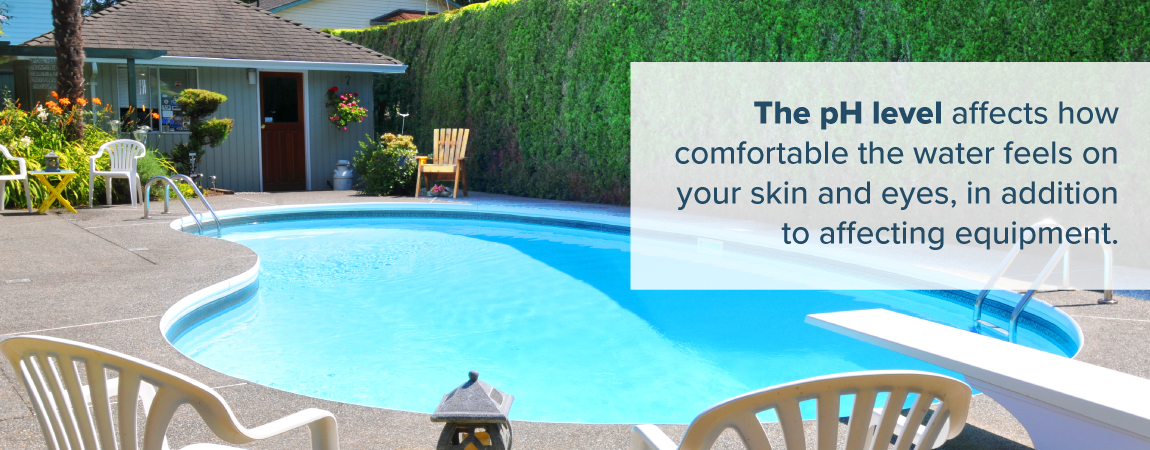
Testing the water is one of the pool maintenance basics that can be intimidating, but the testing process is easy once you learn how to care for an inground pool properly. Pools require testing at least once per week. Testing two to three times is a better option, especially during peak usage. This allows you to adjust chemicals faster before the problem gets out of control.
The typical testing and recommended ranges include:
- pH level from 7.2 to 7.6: The pH level affects how comfortable the water feels on your skin and eyes, in addition to affecting equipment. It also affects the activity of chlorine. Higher pH reduces the amount of active chlorine in the pool, which makes it more difficult to keep your pool clean. A high pH means the water is alkaline, which can irritate skin and form scale in the pool. Low pH creates an acidic environment that irritates the eyes and introduces the potential for corrosion in your pool equipment.
- Free chlorine from one to three parts per million: Proper chlorine levels are essential for controlling bacteria in the water. Free chlorine represents the amount of working chlorine in the water that can kill bacteria. Total chlorine measures all chlorine in the water, even if it isn’t working. These two levels ideally are the same level, but they can be different. When testing, focus on the free chlorine level when determining if the pool needs more chlorination.
- Alkalinity from 80 to 120 parts per million: The total alkalinity typically relates to the pH level. A high total alkalinity often indicates a high pH, just as a low alkalinity often signals a low pH. Proper alkalinity can help keep your pH level stable. A high total alkalinity sometimes causes scaling and cloudiness, while low alkalinity can lead to staining and corrosion. Adjusting alkalinity first and maintaining the recommended alkalinity level can often correct or eliminate pH problems.
- Calcium hardness from 180 to 220 parts per million: Calcium hardness refers to the dissolved calcium that’s in the pool water. Too much calcium leaves deposits on pool components, while low calcium can damage vinyl liners and etch plaster pools.
Since testing is one of the fundamentals of pool maintenance you need to perform often, it’s important to have a quick, easy way to test on your own. Testing strips give you quick results at home to determine if any adjustments are necessary. The strips typically come in bulk packages, so you can perform multiple tests with one package. Follow the testing product directions to get accurate results.
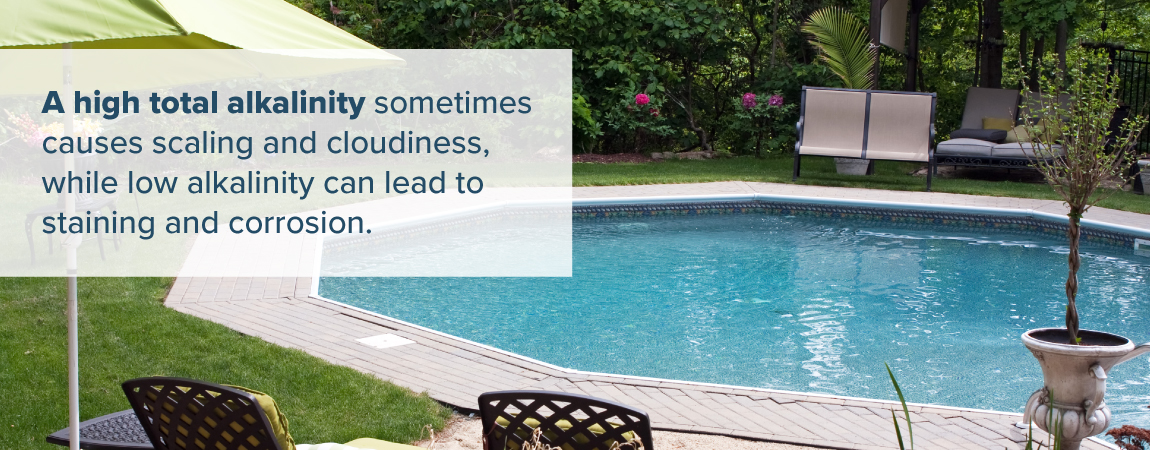
Chemical Care Routine
Home pool maintenance involves periodically adding chemicals in appropriate amounts to maintain safe and comfortable pool water. These chemicals help control contaminants, minimize algae growth, remove dirt from the pool and maintain comfortable levels.
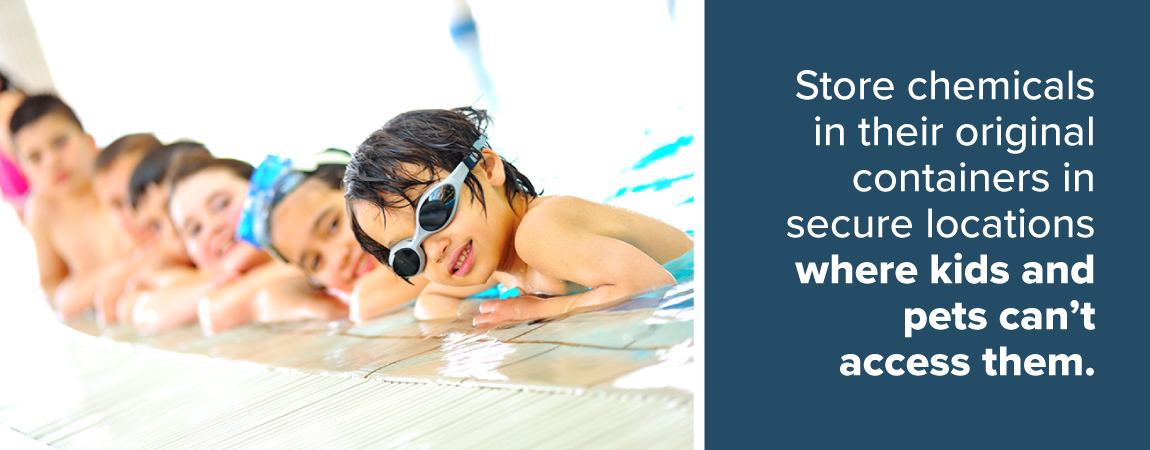
DIY pool care is relatively safe, but the chemicals that keep your pool running properly do require careful handling. Protect your family with these chemical safety tips:
- Store chemicals in their original containers in secure locations where kids and pets can’t access them. Never reuse the containers for any purpose.
- Protect yourself with goggles and rubber gloves when handling chemicals. Wash your hands immediately after handling the chemicals.
- Follow all directions on the packaging, including the amount of chemicals you use. Never combine different chemicals.
- Use designated measuring tools for chemicals. Do not use those tools for any other purpose. Clean the measuring tools after each use.
- Dispose of chemicals and containers properly according to local laws. Don’t just throw away the chemicals or containers in a regular trash can. If you spill chemicals, do not return them to the container.
- Start with fresh chemicals at the beginning of each season.
- Keep the chemicals away from flames and heat, as many of the routine pool care chemicals are flammable.
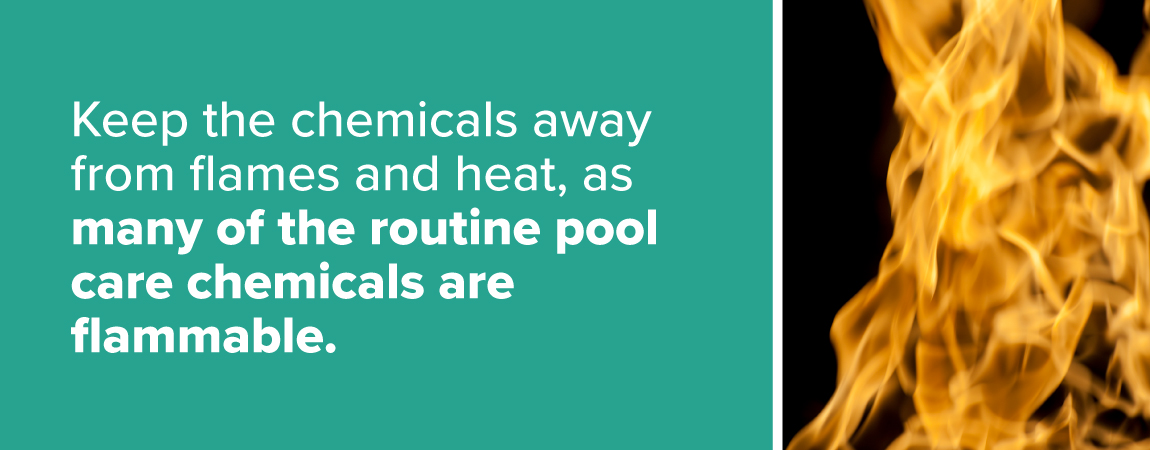
Chlorine is one of the primary chemicals you need to add to your inground pool. The chlorine sanitizes the water, killing bacteria and making it safe for swimmers. Some pools include a chlorinator, which is near the filter and automatically adds chlorine to the water as it passes through the circulation system. Other pools use floating chlorine dispensers that work on a timed-release basis.
Stabilized chlorine resists burn-off in sunlight, maximizing the chlorine available in the water. Chlorine comes in different forms, including:
- Tablets: Chlorinating tablets are easy to use because they’re in a solid form. They work with any type of chlorine application system, including a chlorinator and a floating dispenser. You can also use the tabs in the skimmer.
- Combination tablets: Some chlorinating tablets include other chemicals for extra support, such as additives to kill algae or shock the pool. They work in the same way as basic chlorinating tablets.
- Liquid chlorine: The liquid form of chlorine is easy to use. Most liquid chlorine has a shelf life of only a few weeks, so you’ll need to continually buy new bottles.
- Granules: Granular products often combine several tasks into one product, such as chlorinating and killing algae at the same time.
- Sticks: Chlorinating sticks work in the skimmer of your pool to effectively add chlorine to the water.
The amount of chlorine depends on a variety of factors, including the size of the pool, the frequency of use and the temperature. High temperatures, either due to the outdoor temperature or the use of a pool heater, requires increased chlorine amounts. Always follow the chlorine product’s recommendations based on the size of the pool as a starting point for determining chlorine amounts.
Shocking the pool is another chemical care task for pools. Shocking basically means you super-chlorinate the pool water to increase free chlorine levels and destroy algae, bacteria and other contaminants. This process helps improve water quality and minimize the chlorine smell. Standard practice is to shock the pool once per week.
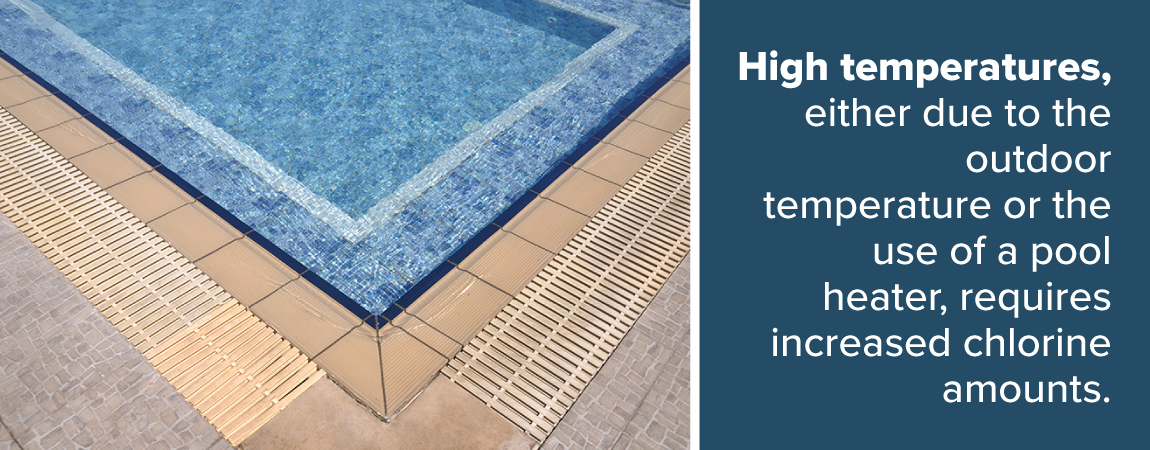
Certain conditions indicate the need for shocking the pool more than the normal weekly process. Those conditions include:
- Chlorine levels below one part per million
- Alkalinity below 90 parts per million
- Algae growth
- After heavy use
- After a storm or heavy periods of rain
- Visible water cloudiness
Algaecide is another pool chemical option. While an effective sanitation system should keep algae growth under control, algaecide is a way to provide even more algae-fighting power for your pool. Add algaecide after shocking the pool.
If your testing reveals issues with the pH level, additional chemicals are required. High pH levels require a pH decreaser to get back to the recommended 7.2 to 7.6 range. Muriatic acid is commonly used to decrease pH levels. The pool size, test results and product directions help you determine how much to add.
To remedy low pH, add pH increaser to raise the levels. Soda ash is the most common method of increasing pH.
Opening the Pool
The beginning of the swimming season requires special pool care tips to get the water ready. This pool maintenance guide component helps you clean, fill and prep the pool, while ensuring all components are operational.
Tasks involved in opening the pool for the swimming season include:
- Remove the cover: If you use a cover on your pool for the winter, clean off debris to keep the junk out of the pool. Remove the cover once it’s clean.
- Clean the pool: Even with a cover, some debris may enter the pool, skimmer, filters, pump and drains. Remove debris from these areas.
- Attach components: Reconnect all of the pumps, filters, electrical connections and hoses. Visually inspect all of these components to look for any damage that may have occurred over the winter months. Address those issues if found.
- Fill the pool: With everything attached and clean, it’s time to fill the pool to the normal water level. Once full, start up the circulation system to start filtering the water. Check for proper functioning in the drains, filters and skimmers. Diagnosing issues early lets you fix them before the swimming system is in full swing, so you don’t miss any opportunities to enjoy the water.
- Vacuum: You may notice debris or areas that aren’t clean. Get out the pool vacuum and go over all surfaces to start the season with a thorough cleaning.
- Test the water: Give the pool filter a chance to run for about four hours before you test the water. This helps you determine the proper chemicals needed to get the water in shape for swimming.
- Shock the pool: After adding the necessary chemicals, shock the pool. Your pool is now ready for your first dip of the season.
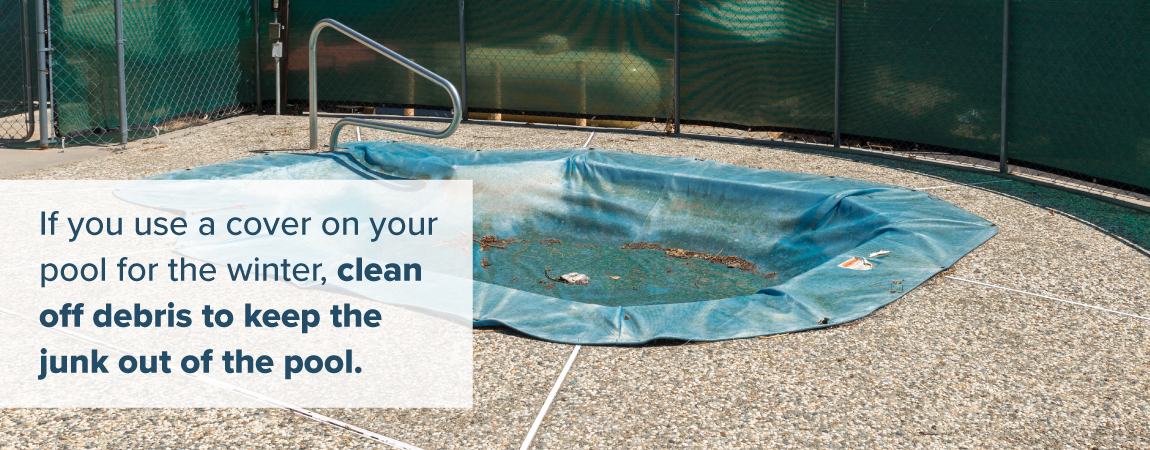
Closing the Pool
The fundamentals of pool care continue until you finish the swimming season and winterize the pool for the year. Your inground pool needs to be partially drained if you live in a cold climate or won’t use the pool for the winter. Some pools may need to be completely drained, but most benefit from having some water remain, as this can prevent cracking or movement out of the ground. Follow the recommendations from your pool manufacturer.
Closing the pool takes a few days to fully prep the pool and minimize issues over the winter. Follow these steps:
- Make adjustments: The pH level is still important as you winterize the pool. Ensure the water is between 7.2 and 7.8. Make adjustments if necessary to achieve this range. Shock the pool at the same time.
- Clean the pool: Turn on the filter and let it run for 24 to 48 hours. Use a long-handled skimmer to remove large pieces of debris. Run the vacuum for additional cleaning. Prevent algae growth by adding algaecide to the water.
- Drain the pool: Use the manufacturer’s recommendations to drain some of the water to achieve the desired lower level.
- Shut down components: Pumps, heaters and other equipment last through the winter with proper protection. Turn them off and store them in a protected area for the winter. Disconnect all power sources to all parts of the pool system. If your pool runs on a circuit breaker system, the easiest option is to turn those breakers to the off position.
- Remove extras: If your pool has a diving board, slide or other extra items, remove them for storage. Put all pool tools and other items in the area in a covered storage area.
- Cover the pool: Your pool is ready to rest for the winter. Secure the cover to the pool, ensuring the cover seals properly to prevent wind and debris from getting underneath it.
Simplify Inground Pool Maintenance
Learning how to maintain a swimming pool keeps your pool up and running efficiently, but you can make inground pool maintenance even easier by installing a pool enclosure. A quality enclosure keeps debris out of your pool, making DIY pool maintenance and cleaning easier. Protection from rain helps maintain the pool’s pH level with fewer chemicals.
Follow our swimming pool maintenance guide to keep your pool crystal clear and comfortable. And while you’re here, consider contacting CCSI International for more information about how pool enclosures can eliminate the common headaches associated with pool ownership.
